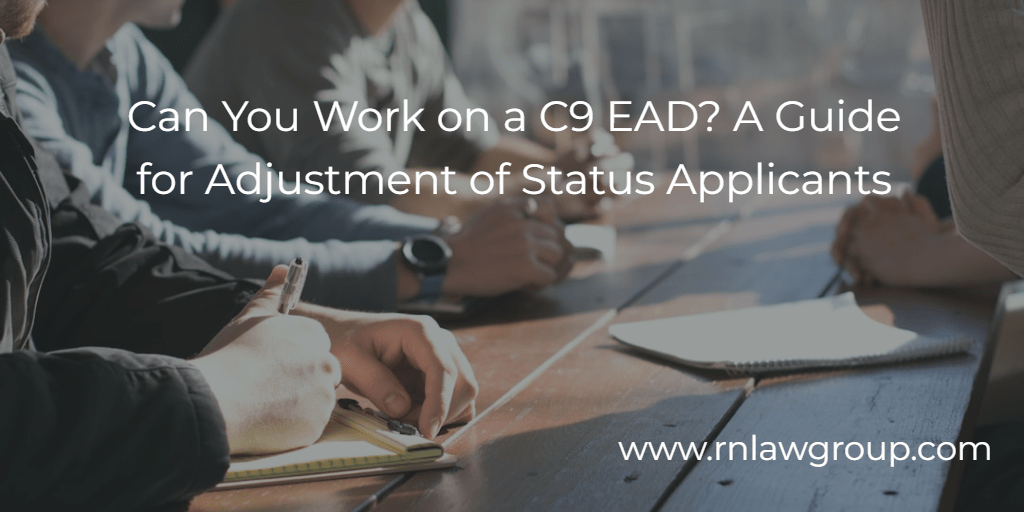
Can You Work on a C9 EAD? A Guide for Adjustment of Status Applicants
What Is the C9 Employment Authorization Document (EAD)?
The C9 Employment Authorization Document (EAD) is a work permit granted to individuals who have a pending Form I-485, the Application to Adjust Status for permanent residency in the United States. This specific category allows applicants to legally work while their Green Card application is being processed.
Who Is Eligible for the C9 EAD? How Long Is a C9 EAD Valid?
Anyone with a pending I-485 is eligible to apply for the C9 EAD, which is typically valid for one, two, or five years, depending on the length of the I-485 processing times. The permit can be renewed if the I-485 remains pending. In many cases, applicants also apply for Advance Parole (Form I-131) simultaneously, which allows for legal re-entry into the U.S. after traveling abroad while awaiting their Green Card decision.
Work Flexibility with the C9 EAD: Types of Jobs You Can Take and What You Should Avoid
There are no specific restrictions on the type of job or company an individual can work for with a C9 Employment Authorization Document (EAD). Once the C9 EAD is approved, the holder can work for any employer in the United States, in any occupation or industry, and there are no limitations on the nature of the job or employment sector. Additionally, the holder is free to switch jobs, work part-time or full-time, or even start their own business. However, it is important to note that the applicant cannot work in any job related to the marijuana industry, even if it is legal in their state. Marijuana remains illegal under federal law, and working in this industry can negatively impact immigration status and applications, as U.S. immigration law operates under federal regulations.
Maintaining a Valid Job Offer for Employment-Based I-485 Applicants
In addition, the main applicant of an employment-based I-485 (Application to Adjust Status) must have a legitimate job offer that supports their application. This job offer must be from the employer who originally sponsored the applicant for the employment-based immigrant petition or must qualify under the American Competitiveness in the 21st Century Act (AC-21).
In other words, although the c9 EAD does not restrict who an Adjustment of Status applicant can work for, the main applicant of an employment-based I-485 must ensure that their job offer remains valid and continues to support their Green Card application. This means the applicant can freely work in any job with the C9 EAD, but if they are the principal beneficiary of an employment-based petition, they must either maintain the original job offer with their sponsoring employer or, if they choose to change jobs, ensure that the new position qualifies under AC-21 portability. The new job must be in the same or a similar occupation to the one initially offered by the sponsoring employer to preserve the validity of the pending I-485 application.
Secondary Employment and the C9 EAD: What You Need to Know
Even with the requirement that the main applicant of an employment-based I-485 must maintain a legitimate job offer that supports their Green Card application, they are not restricted from working a second job that does not directly support the application. The C9 EAD grants the applicant full work authorization, allowing them to take on additional employment in any field or industry. This means that while the applicant must continue to have a valid job offer from the sponsoring employer or a qualifying job under AC-21 portability to support their Green Card process, they are free to pursue secondary employment or side jobs in completely unrelated fields if they choose. The key requirement is that the primary job related to the Green Card application remains valid, but any other jobs taken on are unrestricted by this requirement.
USCIS Scrutiny: How to Address Concerns About Secondary Jobs
Sometimes, USCIS may not fully recognize or understand the flexibility granted by a C9 EAD, which allows the main applicant of an employment-based I-485 to work in any job, including secondary employment. As a result, they might raise questions or concerns if they notice the applicant engaging in employment outside of the primary job that supports the Green Card application.
This can happen because USCIS’s primary focus is on ensuring that the applicant maintains a legitimate job offer tied to their I-485, either with the sponsoring employer or through an AC-21 qualifying job change. If the applicant is working a second job in a different industry or role, USCIS may mistakenly assume that this secondary employment could impact the validity of the Green Card process. In such cases, the applicant may need to clarify that while the secondary job is unrelated, they still have a valid, primary job offer that supports their adjustment of status, as permitted by law.
Documents to Maintain When Working a Second Job with a C9 EAD
If an applicant with a pending employment-based I-485 works a second job in a different industry or role, it’s important to maintain certain documents to demonstrate compliance with immigration requirements and to clarify the distinction between their primary and secondary employment. Key documents to maintain include:
- Primary Job Offer Letter: Keep a copy of the original or updated job offer letter from the sponsoring employer, or from the new employer if the job has been ported under AC-21. This shows that the applicant has a valid offer of employment that supports their Green Card application.
- Proof of Primary Employment: Maintain pay stubs, W-2s, and employment verification letters from the primary employer to confirm ongoing employment in the job related to the I-485 application. This helps demonstrate that the applicant is fulfilling the requirement to maintain a qualifying job.
- Employment Records for Secondary Job: Retain pay stubs, tax records, or offer letters for any secondary employment. While this employment does not directly support the Green Card application, these records can help verify that the secondary job is unrelated and does not interfere with the primary employment.
- Explanation of Job Roles: In case of a USCIS inquiry, it may be helpful to maintain a brief explanation of both the primary and secondary job roles, highlighting that the secondary job is unrelated to the Green Card application, and that the primary job continues to align with the I-485 requirements.
By keeping these documents organized and readily available, the applicant can address any USCIS concerns or questions regarding their employment status while their I-485 is pending.
The Impact of the C9 EAD on Nonimmigrant Status
Furthermore, while an individual can lawfully remain in the U.S. based on their pending adjustment of status and can use their C9 EAD to work, doing so may not be consistent with maintaining their nonimmigrant status. In many cases, the use of the C9 EAD could be seen as an indication that the applicant is no longer adhering to the terms of their nonimmigrant visa. For instance, some nonimmigrant statuses, such as F-1 (student) or B-2 (visitor), have strict limitations on employment. Once the applicant begins using the C9 EAD to work, they may no longer be considered to be maintaining their original nonimmigrant status, even though they remain lawfully present in the U.S. based on their pending I-485 application. It’s important to understand that while the C9 EAD provides work authorization, it may affect the individual’s ability to return to their nonimmigrant status if the adjustment of status application is denied or withdrawn.
Key Takeaways for Employment Flexibility with a C9 EAD and I-485 Applications
While the C9 EAD provides significant work flexibility to individuals with a pending I-485 application, it is essential to understand the implications and responsibilities associated with using this work permit. Although the C9 EAD allows for lawful employment in any field and for any employer, including the option to take on secondary jobs or start a business, employment-based I-485 applicants must ensure that their primary job offer remains valid and aligned with their Green Card application. Maintaining proper documentation, especially when working multiple jobs, can help clarify their employment situation if USCIS raises any concerns. Furthermore, applicants should be mindful that working under the C9 EAD may not be consistent with maintaining their previous nonimmigrant status, which could affect their ability to revert to that status if necessary. Ultimately, careful compliance with both employment and immigration regulations will help ensure a smooth adjustment of status process.
For over 25 years, Reddy Neumann Brown PC has focused solely on U.S. employment-based immigration, and works with employers to establish best practices when navigating the PERM labor certification process. If you are in need of a U.S. work visa or permanent residency, speak with one of our immigration lawyers. Please contact us online, call our Houston business immigration office directly at 713-953-7787 or schedule a consultation.
By: Emily Neumann
Emily Neumann is Managing Partner at Reddy Neumann Brown PC with over 15 years of experience practicing US immigration law providing services to U.S. businesses and multinational corporations. Emily has helped transform the firm from a solo practice to Houston’s largest immigration law firm focused exclusively on U.S. employment-based immigration. She received her Bachelor’s degree in Biology from Central Michigan University and her Juris Doctorate degree from the University of Houston Law Center. Emily is a frequent speaker and has been quoted in Forbes, Bloomberg Law, U.S. News & World Report, Inside Higher Ed, and The Times of India on various hot topics in immigration. She is a member of the American Immigration Lawyers Association and Society for Human Resource Management.

